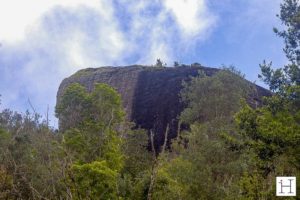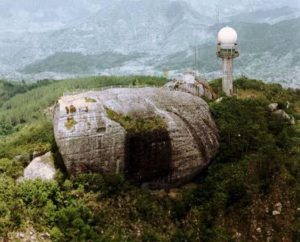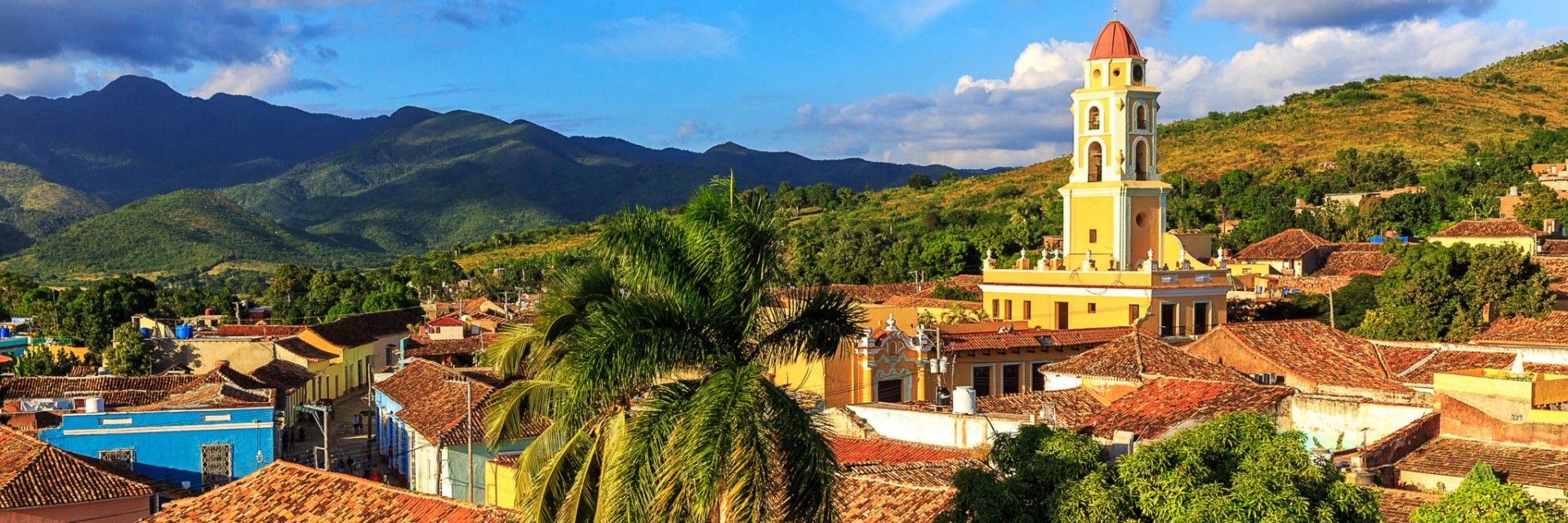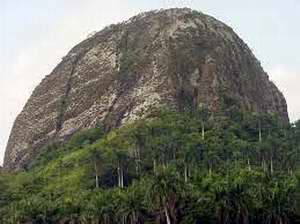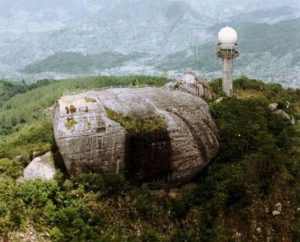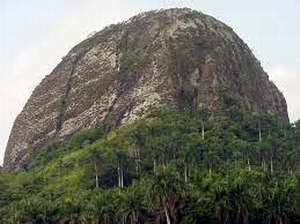 LA GRAN PIEDRA, LA ENORME ROCA VOLCANICA DEL ORIENTE CUBANO. FLORA Y FAUNA.
LA GRAN PIEDRA, LA ENORME ROCA VOLCANICA DEL ORIENTE CUBANO. FLORA Y FAUNA.
La Gran Piedra, tesoro del oriente cubano. Gigantesca mole de piedra, testigo del vulcanismo del Paleógeno, al igual que toda la geología de la Sierra Maestra donde están presentes estratos de este tipo de rocas, compuestas de tobas, ceniza y demás fragmentos de rocas y productos líquidos, como mantos de lava volcánica.
Ubicada en la Carretera de Siboney y Carretera la Gran Piedra km. 14, Santiago de Cuba.La enorme roca de brecha volcánica, de 51 metros de largo y de 25 a 30 metros de ancho, con un peso calculado de 63 000 toneladas se encuentra en la cima de una montaña a 1 225 metros de altura sobre el nivel del mar.
Zona de asentamiento de colonos franceses en los siglos XVIII y XIX, que realizaron construcciones que son ejemplos excepcionales de arquitectura vernácula e industrial. La mole es famosa no solo entre las fronteras de la isla, sino también en la región del Caribe insular, pues es precisamente la de mayor tamaño en esa zona. Declarado Monumento Nacional el 30 de diciembre de 1991.
La flora es exclusiva, pues la componen 222 variedades de helechos, y 352 de orquídeas, eucaliptos, pinos maestrenses, cubenses, cipreses, y una variedad de frutales entre ellos, por insólito que parezca, manzanas legítimas y melocotones.
La fauna de la Gran Piedra es, uno de los atractivos más fuertes. En torno a la mole , vuelan pájaros carpinteros, zorzales reales, cartacubas, gavilanes, torcazas, mayitos, capitaneados por nuestra ave nacional, el tocororo. A sólo un kilómetro se encuentra el Jardín Botánico, donde se cultivan de forma excepcional, especies como el ave del paraíso, las dalias, magnolias y otras de climas fríos, aprovechando el microclima que reina en la zona. La cortina de nubes que baja hasta tocar el suelo tapizado de musgos siempre húmedos, suele impregnar de misterio y enigma el encuentro de los hombres con la mole de piedra, que sólo la fuerza descomunal generada en las entrañas de un volcán, pudo haber lanzado hasta aquella montaña.
Comoquiera que el fenómeno está por confirmarse, lo cierto es que la gigantesca roca es el epicentro de uno de los parajes naturales de mayor belleza de la zona, porque ofrece vistas de altos contrastes. Desde alli se puede la ciudad de Santiago de Cuba, con sus edificios de 18 plantas desafiando la sismicidad del terreno, y las ruinas pétreas de mansiones señoriales y secaderos de café que significan la huella francohaitiana en estos lomeríos.
El microclima existente en la zona permite disfrutar de temperaturas que han llegado a descender hasta cuatro grados centígrados, caracterizándose por la expansión de una densa niebla que, incluso en verano, impide divisar a una persona a más de un metro de distancia.
Para ascender a la piedra, el visitante se enfrenta con la emocionante aventura de escalar, envuelto en la densa neblina, 452 peldaños, escoltados por una tupida vegetación de helechos, orquídeas y otras especies, que perfuman el ambiente. La subida requiere de la toma de aire en los tres descansos existentes.
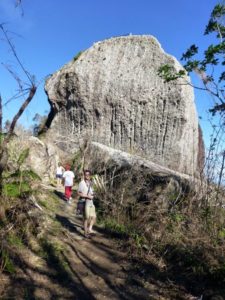 THE GREAT STONE (LA GRAN PIEDRA), THE HUGE VOLCANO ROCK OF EASTERN CUBA. FLORA AND FAUNA.
THE GREAT STONE (LA GRAN PIEDRA), THE HUGE VOLCANO ROCK OF EASTERN CUBA. FLORA AND FAUNA.
La Gran Piedra, a treasure of eastern Cuba. Gigantic stone mass, a witness of the volcanism of the Paleogene, as well as the entire geology of the Sierra Maestra where layers of this type of rocks are present, composed of tuffs, ash and other fragments of rocks and liquid products, such as mantles of volcanic lava.
Located on the Siboney Road and the Great Stone Road km. 14, Santiago de Cuba. The huge volcanic gap rock, 51 meters long and 25 to 30 meters wide, with a calculated weight of 63,000 tons is located on the top of a mountain at 1,225 meters high above the sea level.
Settlement area of French settlers in the eighteenth and nineteenth centuries, who made constructions that are exceptional examples of vernacular and industrial architecture. The mole is famous not only between the borders of the island but also in the insular Caribbean region, as it is precisely the largest in that area. Declared National Monument on December 30, 1991.
The flora is exclusive, as it is made up of 222 varieties of ferns, and 352 of orchids, eucalyptus, maestre, pines, cypresses, and a variety of fruit trees among them, as unusual as it may seem, legitimate apples and peaches.
The fauna of the Great Stone is one of the strongest attractions. Around the mole, woodpeckers, royal thrush, beetles, hawks, torcazas, mayitos, captained by our national bird, the tocororo, fly. Only one kilometer away is the Botanical Garden, where species such as the bird of paradise, dahlias, magnolias and other cold climates are grown exceptionally, taking advantage of the microclimate that reigns in the area. The curtain of clouds that goes down to touch the floor covered with always wet mosses often impregnates with mystery and enigma the encounter of men with the stone mass, which only the enormous force generated in the bowels of a volcano, could have launched until that mountain.
Since the phenomenon is yet to be confirmed, the truth is that the giant rock is the epicenter of one of the most beautiful natural sites in the area, because it offers views of high contrasts. From there you can the city of Santiago de Cuba, with its 18-story buildings challenging the seismicity of the land, and the stone ruins of stately mansions and coffee dryers that signify the Franco-Haitian footprint in these lomeríos.
The existing microclimate in the area allows you to enjoy temperatures that have reached down to four degrees Celsius, characterized by the expansion of a dense fog that, even in summer, prevents a person from seeing more than a meter away.
To ascend the stone, the visitor faces the exciting adventure of climbing, wrapped in dense fog, 452 steps, escorted by dense vegetation of ferns, orchids and other species, which perfume the environment. The climb requires the intake of air in the three existing breaks.
Agencies/ Wiki/ Ecured/ Internet Photos/ Arnoldo Varona/ www.TheCubanHistory.com
THE CUBAN HISTORY, HOLLYWOOD.



